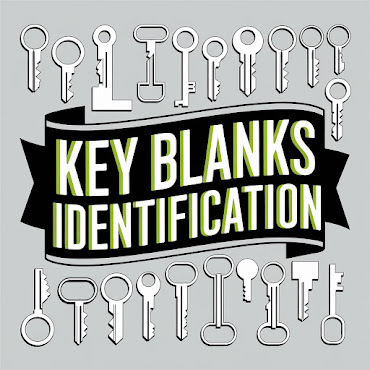What Are Key Blanks? Everything You Need to Know
If you've ever walked into a hardware store or locksmith shop to get a key copied, you’ve likely heard the term “key blank.” But what exactly is a key blank, and why is it such a critical part of the key cutting process?
In this comprehensive guide, we’ll answer the most common questions about key blanks—what they are, the different types, how they're used, and how to identify the right one for your lock. Whether you're a DIY enthusiast, property manager, or professional locksmith, this article is your one-stop resource for understanding key blanks.
What Is a Key Blank?
A key blank is an uncut key that has the correct shape and profile to fit a specific lock, but has not yet been machined to match the unique cuts of your key. In other words, it’s a “template” that a locksmith uses to duplicate a key or create a new one.
Why Are Key Blanks Important?
Key blanks are the foundation of all key duplication and lock rekeying work. Without the correct blank:
- The key won’t fit into the lock’s keyway
- The duplication machine can’t create accurate cuts
- Security and functionality can be compromised
That’s why selecting the correct key blank is crucial for both locksmiths and consumers.
Common Types of Key Blanks
There are hundreds of different key blanks, each designed for a specific brand, lock type, or function. Here are some of the most common categories:
1. House Key Blanks
Used for residential door locks (like Schlage or Kwikset).
Popular types:
- SC1 – Schlage-compatible key blank
- KW1 – Kwikset-compatible key blank
2. Automotive Key Blanks
Used for car ignition and door locks. Some come with transponders or chips.
Popular types:
- B106 – For GM vehicles
- H75 – For Ford models
- TP00HU-HOND-34 – For Honda vehicles
3. Padlock and Cabinet Key Blanks
Used for toolboxes, mailboxes, vending machines, and lockers.
Common brands: American Lock, Master Lock, and Yale
4. High-Security Key Blanks
Used for locks with restricted or patented designs to prevent unauthorized duplication.
Brands: Medeco, Mul-T-Lock, ASSA
5. Tubular Key Blanks
Feature a circular design, typically used in bike locks, vending machines, and some commercial equipment.
6. Decorative Key Blanks
Colorful or uniquely designed blanks that offer personalization without sacrificing functionality.
How to Identify the Right Key Blank
If you're trying to replace or duplicate a key, identifying the correct blank is critical. Here's how to do it:
Check the Keyway or Profile
Look at the grooves on the sides of your original key. The pattern must match exactly.
Look for Key Blank Codes
Most keys have a code stamped on the head (e.g., SC1, KW1, Y1) that identifies the key blank.
Match the Brand and Lock Type
Match your lock brand (e.g., Schlage, Yale, Medeco) with the corresponding key blank catalog.
Use a Key Identification App or Chart
Tools like key identification apps, blank matching charts, and online lookup databases make it easier to find compatible blanks.
Who Uses Key Blanks?
Key blanks are used by:
- Locksmiths – To create duplicate keys, master keys, and rekey locks
- Hardware Stores – For basic key copying services
- Security Professionals – In restricted access systems and high-security environments
- DIY Users – For simple key duplication using key cutting machines
Where to Buy Quality Key Blanks
When shopping for key blanks, quality and compatibility are key. Avoid generic or poorly made blanks that can damage your lock or fail prematurely.
Recommended Sources:
- LockPicks.com – Trusted locksmith supplier with thousands of key blanks in stock
- CLK Supplies – Offers key blanks and educational resources for locksmiths
Key Blanks vs Cut Keys: What’s the Difference?
| Feature | Key Blank | Cut Key |
|---|---|---|
| Cut Profile | Uncut | Custom cuts to match a lock |
| Functionality | Can’t open any lock | Opens one specific lock |
| Use | Used for duplication/cutting | Used for daily operation |
| Availability | Sold by type and code | Created from a key blank |
Frequently Asked Questions (FAQs)
Q1: Can I buy key blanks and cut them myself?
A: Yes, if you have a key cutting machine and know the correct blank type. However, professional locksmiths ensure accuracy and security.
Q2: Are all key blanks universal?
A: No. Key blanks are specific to lock brands and keyways. Using the wrong blank won’t work.
Q3: Can you duplicate a key without the original using a blank?
A: Yes, if you have the key code or lock cylinder information, a locksmith can cut a key from a blank without the original.
Q4: Are novelty key blanks as durable as standard ones?
A: Most are made from the same material (nickel-plated brass or steel), but quality can vary by manufacturer.
Final Thoughts
Understanding what key blanks are is essential whether you're a locksmith, property owner, or someone simply looking to make a spare key. Key blanks come in countless styles, shapes, and security levels—and choosing the right one can mean the difference between a working key and a useless one.
For high-quality key blanks, expert guidance, and a wide selection of brands like ILCO, JMA, and Silca, visit clksupplies.com—your trusted source for all locksmith supplies.

When searching for a locksmith near me, choose a locksmith in Hypoluxo for expert help.
ReplyDelete